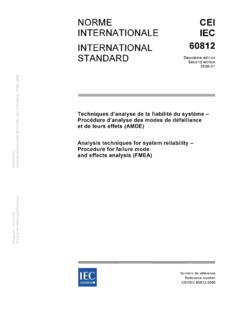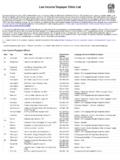Transcription of RR919 - Human factors that lead to non-compliance …
1 Health and Safety Executive Human factors that lead to non- compliance with standard operating procedures Prepared by the Health and Safety Laboratory for the Health and Safety Executive 2012. RR919 . Research Report Health and Safety Executive Human factors that lead to non- compliance with standard operating procedures Simon Bates & Justin Holroyd Health and Safety Laboratory Harpur Hill Buxton Derbyshire SK17 9JN. The Advisory Committee on Dangerous Pathogens categorises biological agents into Hazard Groups 1. (negligible hazard) to 4 (highly pathogenic) according to their potential to cause Human infection, the likelihood that infection could spread in the community, and the availability of effective treatment. For laboratories where biological agents are handled, controls proportionate to these hazards are specified and laboratories are designated Containment Levels 1 to 4. These controls are a combination of structural requirements and working procedures . To protect the health of workers, especially with more pathogenic biological agents, it is important that these controls are applied stringently.
2 This report presents results from the Health and Safety Laboratory's study on the Human factors that lead to non- compliance with Standard operating procedures (SOPs) in Containment Level 3 (CL3) laboratories. The research stemmed from recognition by HSE intervention managers that RIDDOR investigations in CL3. laboratories were often identifying non- compliance with SOPs and organisational learning deficiencies as contributory factors . Understanding the Human factors influences on CL3 laboratory workers that could lead to non- compliance with SOPs will inform HSE HID-SI intervention strategy, thereby helping to drive up safety performance standards in the CL3 laboratory sector. This report and the work it describes were funded by the Health and Safety Executive (HSE). Its contents, including any opinions and/or conclusions expressed, are those of the authors alone and do not necessarily reflect HSE policy. HSE Books Crown copyright 2012. First published 2012. You may reuse this information (not including logos) free of charge in any format or medium, under the terms of the Open Government Licence.
3 To view the licence visit , write to the Information Policy Team, The National Archives, Kew, London TW9 4DU, or email Some images and illustrations may not be owned by the Crown so cannot be reproduced without permission of the copyright owner. Enquiries should be sent to ACKNOWLEDGEMENTS. The authors would like to thank the organisations and their staff who participated in the focus groups, without whom this research would not have been possible. ii KEY MESSAGES. The reasons for cutting corners and the situations where cutting corners could be more likely were mainly found to be due to situational and organisational factors . For example, time pressure, workload, staffing levels, training, supervision, and availability of resources. Controls to address situational and organisational issues, and promote compliance with SOPs, were found to be wide ranging. For example, predicting peaks in demand, planning a realistically achievable workload, and engendering an organisational culture where staff feel able to challenge management pressure Participants reported a particular type' of person, described as being conscientious, patient, willing to comply, and confident but not overconfident, as being best suited to CL3 laboratory work.
4 The SOP systems and documents were reported to be generally usable and fit for purpose. Participants reported a number of features of their SOPs that reflect the literature on accepted good practice, for example, inclusion of visual aids. Participant laboratories all reported having internal systems for capturing information from near misses and incidents and the capacity to learn from those experiences. Some laboratories had a more comprehensive system for sharing information with other laboratories than others. Whilst some differences were apparent in the findings from the various classifications of CL3 laboratories involved in this research (research laboratories, diagnostic laboratories, Human pathogens, animal pathogens, genetic engineering), no significant differences in the main issues emerged. iii iv EXECUTIVE SUMMARY. Introduction The Advisory Committee on Dangerous Pathogens categorises biological agents into Hazard Groups 1 (negligible hazard) to 4 (highly pathogenic) according to their potential to cause Human infection, the likelihood that infection could spread in the community, and the availability of effective treatment.
5 For laboratories where biological agents are handled, controls proportionate to these hazards are specified and laboratories are designated Containment Levels 1 to 4. These controls are a combination of structural requirements and working procedures . To protect the health of workers, especially with more pathogenic biological agents, it is important that these controls are applied stringently. This report presents results from the Health and Safety Laboratory's study on the Human factors that lead to non- compliance with Standard operating procedures (SOPs) in Containment Level 3 (CL3) laboratories. The research stemmed from recognition by HSE. intervention managers that RIDDOR investigations in CL3 laboratories were often identifying non- compliance with SOPs and organisational learning deficiencies as contributory factors . Understanding the Human factors influences on CL3 laboratory workers that could lead to non- compliance with SOPs will inform HSE HID-SI intervention strategy, thereby helping to drive up safety performance standards in the CL3 laboratory sector.
6 Method Six focus groups were carried out across a range of laboratories that reflect the variety of contexts of the CL3 laboratory sector. Data gathered in the focus groups was subject to a rigorous thematic analysis and findings were compared to the literature on accepted good practice for the Human factors that relate to non- compliance with SOPs. Main findings The SOPs were reported to be, in the main, usable and fit for purpose. procedures were said to be up-to-date, contained the right level of detail, and reflected how the tasks were performed. Staff also said they were involved in the development of procedures to ensure they were aligned with the practicalities of carrying out the work. In terms of compliance , a number of reasons and situations were highlighted where corners could be cut. These were primarily situational in nature, relating to organisational factors within the scope of management to influence, for example, time pressure, workload, staffing levels, training, supervision, and availability of facilities were common themes across the six focus groups.
7 On an individual level, the findings suggest that a particular type' of person could be best suited to CL3 laboratory working. Such an individual was described as being conscientious, patient, willing to comply, and confident but not overconfident. Optimising violations were not apparent in the data, which indicates that CL3 laboratory workers are not cutting corners as a result of a need for excitement in their jobs. Controls to address situational and organisational issues include workload and time management, booking timeslots on CL3 facilities, and challenging the pressure from v management. Predicting peaks in demand and planning a realistically achievable workload was reported as likely to have a positive impact on compliance with SOPs. An organisational culture where staff feel able to challenge management pressure was reported to be an important factor in compliance with SOPs. A progressive management approach should recognise this and be mindful that short-term productivity gains could compromise health and safety and set the tone within the work environment where non- compliance with SOPs may become the accepted way of working in order to get the work done in the time available.
8 Whilst some differences were apparent in the findings from the various classifications of CL3. laboratories involved in this research, no significant differences in the main issues emerged. Indeed, the reported reasons for cutting corners' and situations where cutting corners may be more likely' were familiar from research in other industry sectors. This suggests that CL3. laboratories experience similar challenges to other sectors where compliance with safety critical procedures is a common feature of the work. This is a view supported by the research literature. Laboratories that took part in this research all have internal systems for capturing information from near misses and incidents, and learning from those experiences. Whilst this is an accepted approach for development, and is supported by the literature, there is potential benefit in the wider communication of information with other laboratories. Future directions In order to maintain and progress compliance with SOPs, CL3 laboratories should continue with the controls they already have in place but with a particular focus on controls relating to situational violations, as this was the most common area of non- compliance .
9 As situational controls are correlated with organisational factors , it is likely that management will have more influence than laboratory workers. Efforts should therefore be made by management in CL3. laboratories, with support from the regulator, towards engendering a management approach that builds on existing good practice and focuses on the various situational and organisational factors described in this research (for example, workload planning, realistic time scheduling, and availability of resources) in order to maintain compliance with SOPs and, therefore, maintain health and safety standards across the industry. vi CONTENTS PAGE. 1. INTRODUCTION .. 1. Human factors 1. procedures 2. Violations 2. Errors 4. Aims 4. Objectives 4. 2. IMPLICATIONS .. 5. 3. METHODOLOGY .. 7. Study design 7. Sampling strategy and recruitment 7. Preparation of vignettes 7. Qualitative data collection 8. Data analysis 9. Literature search 9. 4. FINDINGS .. 10. Introduction 10. Vignettes 10.
10 Main risks 10. Standard operating procedures 10. Perceptions of risk controls and safety management systems 12. Human factors (non)- compliance with SOPs 16. Organisational learning and communication 18. Findings from the review of targetted literature 20. Limitations 23. 5. CONCLUSIONS .. 25. Cutting corners reasons and situations 25. Following procedures ease and difficulty 26. What can be done to improve compliance with SOPs? 27. Organisational learning and communication 27. Future directions 28. 6. REFERENCES .. 29. 7. 30. Annex 1 Recruitment script for potential participant CL3 laboratories 30. Annex 2 Covering letter for Biological Safety Officers 31. Annex 3 Information document for focus group participants 33. Annex 4 Consent form for focus group participants 34. Annex 5 Vignettes for use in the focus groups 35. Annex 6 Topic guide for use in the focus groups 38. vii viii 1. INTRODUCTION. The Advisory Committee on Dangerous Pathogens (ACDP) is an expert body comprising of representatives from HSE, other Government agencies and academic scientists.















